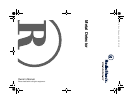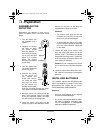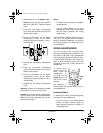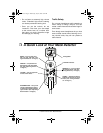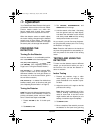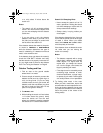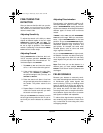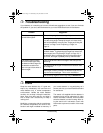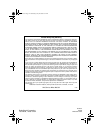
7
Operation
ˆ
Operation
Your RadioShack Metal Detector distinguish-
es between ferrous and non-ferrous metals.
Ferrous metals contain iron, while non-
ferrous metals such as gold, silver, copper,
platinum, aluminum, lead, and zinc do not.
When the detector senses a metallic object,
the meter reading changes and the detector
sounds one of three tones. The tone de-
pends on what metal is detected. The higher
the tone’s pitch, the stronger the detection.
PREPARING THE
DETECTOR
Turning On the Detector
Hold the detector in a comfortable position,
then rotate
MODE
to the desired position.
VLF (Very Low Frequency)
— to adjust
TUNE
and
GROUND
. (See “Adjusting Ground” on
Page 9 and “Tuning the Detector” below.)
TR1 (Transmit 1)
— to detect extreme differ-
ences in metals, such as iron and gold. The
difference between iron and gold shows on
the meter (iron in the ferrous section, gold in
the non-ferrous section).
TR2 (Transmit 2)
— to detect finer distinctions
between metals, such as aluminum and gold
(see “Adjusting Discrimination” on Page 9).
Tuning the Detector
TUNE
fine-tunes the balance between the de-
tector’s receiver and transmitter circuitry to
provide consistent pointer and tone indica-
tions. Follow these steps to set
TUNE
.
1. Rotate
VOLUME
to the 10 o’clock posi-
tion.
2. Set
MODE
to
VLF
.
3. Set
GROUND
,
DISCRIMINATION
, and
SENSITIVITY
to mid-range.
4. Hold the search coil at least 1 foot away
from the ground and any metal object,
hold down the red button on the handle
and slowly rotate
TUNE
until the analog
meter pointer resets at or near 0.
As you search, you can fine-tune the detec-
tor using the other controls (see “Fine-Tuning
the Detector” on Page 9).
Note:
Press the red button on the handle at
any time during operation to automatically re-
turn the pointer to the center of the analog
meter.
TESTING AND USING THE
DETECTOR
To learn how the detector reacts to different
metals, you should test it before you use it
the first time. You can test the detector in-
doors or outdoors.
Indoor Testing
1. Remove any watches, rings, or other
metal jewelry you are wearing, then
place the detector on a wooden or plas-
tic table.
2. Adjust the search coil’s angle so the flat
part faces the ceiling.
Note:
Never test the detector on a floor
inside a building. Most buildings have
metal of some kind in the floor, which
might interfere with the objects you are
testing or mask the signal completely.
3. Set
MODE
to
TR1
.
4. Move a sample of the material you want
the detector to find (such as a gold ring
63-3013.fm Page 7 Wednesday, July 26, 2000 9:42 AM



